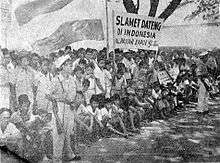Hubertus van Mook
| Hubertus van Mook | |
|---|---|
 Hubertus van Mook in 1942 | |
| Governor-General of the Dutch East Indies | |
|
In office 1942–1948 | |
| Monarch | Wilhelmina |
| Preceded by | Tjarda van Starkenborgh Stachouwer |
| Succeeded by | Louis Beel |
| Personal details | |
| Born |
Hubertus Johannes van Mook 30 May 1894 Semarang, Dutch East Indies |
| Died |
10 May 1965 (aged 70) L'Isle-sur-la-Sorgue, France |
Hubertus Johannes "Huib" van Mook (30 May 1894 – 10 May 1965) was a Dutch administrator in the East Indies. During the Indonesian National Revolution, he served as the Acting Governor-General of the Dutch East Indies from 1942 to 1948.[1] van Mook also had a son named Cornelius van Mook who studied marine engineering at the Massachusetts Institute of Technology.[1] He also wrote about Java - and his work on Kota Gede is a good example of a colonial bureaucrat capable of examining and writing about local folklore.
Biography
Hubertus van Mook was born in Semarang in Java on 30 May 1894. As with many Dutch and Indos growing up in the East Indies, he came to regard the colony particularly Java as his home.[2] Following the Japanese conquest of Indonesia in 1942, Hubertus van Mook was appointed as Acting Governor-General by the Dutch East Indies government in exile near Brisbane, Australia.[3] Due to his liberal inclinations and sympathies towards Indonesian nationalism, many conservative Dutch distrusted his policies and he was never given the full title of Governor-General.[4] Due to the weakened position of the Dutch due to the Nazi invasion and occupation, much of the task of retaking the East Indies following the Japanese surrender in August 1945 was carried out by Australian and British forces. While Australian forces succeeded in occupying the Outer Islands with minimal resistance, British forces in Java and Sumatra were challenged by a nascent Indonesian Republic led by Sukarno and Hatta.

On 1 October 1945 van Mook arrived back in Java along with elements of the Netherlands Indies Civil Administration. However, their presence generated much outrage from much of the Indonesian populace who were opposed to the restoration of Dutch colonial rule.[2] with Dutch support being limited to Christian areas like Ambon and Manado, which were at that time (not before WWII) the chief sources of recruitment for the Royal Dutch East Indies Army.[5] While he planned to grant independence to Indonesia, he advocated a federal Republic of the United States of Indonesia with strong political and economic ties to the Netherlands. He regarded Sukarno's Republic as economically inept and unable to ward off the Indonesian Chinese, Indonesian Indians and the rising Indonesian Communist Party.[6]
The above factors and violations of the Linggadjati Agreement prompted the East Indies government to launch a police action in mid-1947 known as Operatie Product. The KNIL and Royal Netherlands Army occupied large areas of Java and Sumatra, with the Republican army offering only weak resistance.[7] However, the Dutch were held back from full conquest of the Republic due to pressure from the UN Security Council and the United States, who called for a ceasefire.[8] This led to the announcement of a ceasefire in January 1948 followed by a formal armistice. As a consequence, what was previously considered to be an internal Dutch affair now took on an international dimension.
The Renville Agreement, as the armistice was called, stipulated the withdrawal of Indonesian forces from Dutch-occupied territory and the establishment of a ceasefire boundary known as the Van Mook Line.[9] After some time, however, the Indonesian military, secretly, returned and began guerrilla operations against the Dutch. This led to a second major Dutch police action known as Operatie Kraai in December 1948.[10]
Notes and references
- 1 2 Kahin (2003), p. 23
- 1 2 Bayly and Harper (2007), p. 170
- ↑ Bayly and Harper (2007), p. 167
- ↑ Kahin (2003), p. 24
- ↑ Bayly and Harper (2007), p. 171
- ↑ Kahin (2003), p. 27
- ↑ Jackson (2008), p. 22
- ↑ Spruyt (2005), p.150
- ↑ Kahin (2003), p. 29
- ↑ "Agressi II: Operatie Kraai. De vergeten beelden van de tweede politionele actie. Orig. edn. - ZWEERS, L". Antiqbook.nl. Retrieved 2012-09-21.
References
- Bayly, Christopher; Harper, Tim (2007). Forgotten Wars: The End of Britain's Asian Empire. Allen Lane. ISBN 0-7139-9782-6.
- Cheong, Yong Mun (1982). H.J. Van Mook and Indonesian Independence: A Study of His Role in Dutch-Indonesian Relations, 1945-48. The Hague: Nijhoff.
- Kahin, George McTurnan (1952). Nationalism and Revolution in Indonesia. Cornell University Press. ISBN 0-8014-9108-8.
- Kahin, George McTurnan; Audrey Kahin (2003). Southeast Asia: A Testament. London: Routledge Curzon. ISBN 0-415-29975-6.
- Ricklefs, M.C. (1993). A History of Modern Indonesia Since c. 1300. San Francisco: Stanford University Press.
- Spruyt, Hendrik (2005). Ending Empire: Contested Sovereignty and Territorial Partition. Ithaca, New York: Cornell University Press.
- Zweers, L. (1995). Agressi II: Operatie Kraai. De vergeten beelden van de tweede politionele actie. The Hague: SDU Uitgevers.
External links
| Wikimedia Commons has media related to Hubertus van Mook. |
| Political offices | ||
|---|---|---|
| Preceded by Alidius Warmoldus Lambertus Tjarda van Starkenborgh Stachouwer |
Governor-General of the Dutch East Indies 1942–1948 |
Succeeded by Louis Beel |
| Preceded by Pieter Sjoerds Gerbrandy |
Minister of Colonial Affairs 1942-1945 |
Succeeded by Josef Ignaz Julius Maria Schmutzer |
